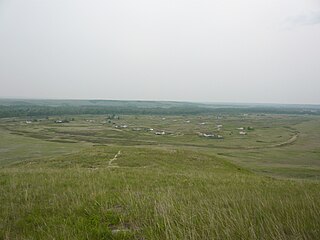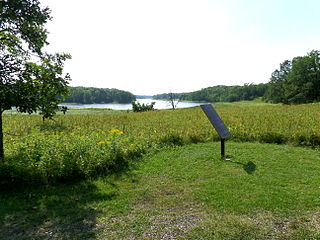 W
WBlackfoot Crossing Historical Park is a complex of historic sites on the Siksika 146 Indian reserve in Alberta, Canada. This crossing of the Bow River was traditionally a bison-hunting and gathering place for the Siksika people and their allies in the Blackfoot Confederacy.
 W
WThe British Block Cairn (Ed0p-1) is located on the Suffield Block in Alberta, Canada. In the summers of 1961 and 1962, the Chief Superintendent of the Suffield Experimental Station, Mr. A. M. Pennie, granted crews from the Glenbow Foundation, consisting of R.G. Forbis, D. R. King, Frank O'Leary, Kenneth Smith, John Miller, and James Farmilo, access to the cairn. Dating from around 1400 C.E, the site consists of a large boulder cairn surrounded by a ring of stones and a human effigy figure.
 W
WThe Frog Lake Massacre was part of the Cree uprising during the North-West Rebellion in western Canada. Led by Wandering Spirit, young Cree men attacked officials, clergy and settlers in the small settlement of Frog Lake in the District of Saskatchewan in the North-West Territories on 2 April 1885. Nine settlers were killed in the incident.
 W
WHead-Smashed-In Buffalo Jump is a buffalo jump located where the foothills of the Rocky Mountains begin to rise from the prairie 18 km (11.2 mi) west of Fort Macleod, Alberta, Canada on highway 785. It is a UNESCO World Heritage Site and home of a museum of Blackfoot culture. Joe Crowshoe Sr. (1903–1999) – Aapohsoy’yiis – a ceremonial Elder of the Piikani Nation in southern Alberta, was instrumental in the development of the site. The Joe Crow Shoe Sr. Lodge is dedicated to his memory. He dedicated his life to preserving Aboriginal culture and promoting the relationship between Aboriginal and non-Aboriginal people and in 1998 was awarded the National Aboriginal Achievement Award for "saving the knowledge and practices of the Blackfoot people."
 W
WThe Kay-Nah-Chi-Wah-Nung Historical Centre, or Manitou Mounds, is Canada's premier concentration of ancient burial mounds. Manitou Mounds National Historic Site, as it was once called, is a vast network of 30 village sites and 15 ancient burial mounds constructed from approximately 5000 BP during the Archaic Period, to 360 BP; it is one of the "most significant centres of early habitation and ceremonial burial in Canada." It is located on a river stretch known as Long Sault Rapids on the north side of Rainy River, approximately 54 kilometres (34 mi) east of Fort Frances, in the Rainy River District of Northwestern Ontario, Canada off highway 11. It was designated as a National Historic Site of Canada in 1969.
 W
WTr'ochëk is the site of a traditional Hän fishing camp at the confluence of the Klondike River and Yukon River. The site is owned and managed by the Tr’ondëk Hwëch’in First Nation, and is operated by the First Nation's Department of Heritage.
 W
WWriting-on-Stone Provincial Park is located about 100 kilometres (60 mi) southeast of Lethbridge, Alberta, Canada, or 44 kilometres (30 mi) east of the community of Milk River, and straddles the Milk River itself. It is one of the largest areas of protected prairie in the Alberta park system, and serves as both a nature preserve and protection for many First Nations (indigenous) rock carvings and paintings. The park is sacred to the Blackfoot and many other aboriginal tribes.